The Sonoma Valley Museum of Art puts local talent on vivid display
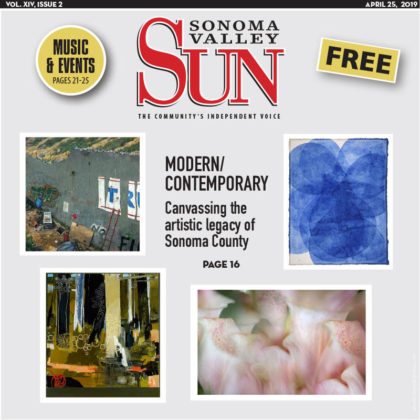 In its current exhibition, open now through June 16, the SVMA presents works of contemporary artists who have lived and worked in Sonoma County. The Sun’s Jackie Lee spoke with four of them.
In its current exhibition, open now through June 16, the SVMA presents works of contemporary artists who have lived and worked in Sonoma County. The Sun’s Jackie Lee spoke with four of them.
Chester Arnold
Chester Arnold has been a treasured artist and personality since 1993 when he and his wife Frances and their children moved to Sonoma, where Frances’ parents were living. He taught art at the College of Marin and Sonoma State University,
Recounting his early years, Chester said, “My father was in army intelligence, and eventually worked for the NSA in espionage in Europe from 1957 to 1969. We lived in Munich then, and I benefited from a good education. I was exposed to a lot of art in museums, and as a result I was wired visually more than in other branches of ability and knowledge.
“Ted Akimoto was my art teacher in high school, and a mentor to me in so many ways. He saw something that distinguished me even though I couldn’t see it. I wanted to be a part of the art world, I didn’t know how or why, but I wanted it to be my career. These were my people; they spoke my language and I felt that.”
Arnold recently retired from College of Marin after 30 years. “The time had come to retire, but I believe I became a complete human being by teaching. In the beginning of my art career, I spent 20 years working at night and painting in the day. It was the most exciting and vibrant time of my life, and I learned that to attain happiness you need to have responsibility.”
Asked about his “detritus” series, Chester explained, “Robert Colescott painted piles of stuff and William Wylie’s work was always full of stuff. When I became a parent and we started accumulating the many accoutrements of a modern life with children in America, I felt I had a connection to image making that could include those things as a reflection of the simultaneous success and failure of our society. It’s the interesting dilemma faced by all of humanity. Now, I need new visual experiences to take me to a more vital place in art making.”
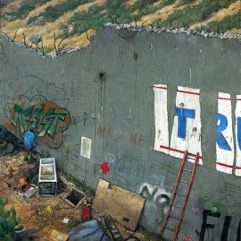
Chester’s painting entitled “Borderline” in the SVMA exhibition is large in size and provocative in tone, but undeniably timely on one of the most important issues of the day.
“The painting concerns the complete human plight,” said Chester. “The Trump wall does nothing to solve the problems, it’s a waste of money. I made up my own scenario for the painting about the degradation of culture over time. It’s an obvious statement about the uselessness of a wall, but some people may have other ideas. The extremely abstract flat plane brings a strong basic structure to the format. Conceptually and formally it is liberating in some ways and I love the simplicity of the composition.”
Chester has been represented by Catharine Clark Gallery in San Francisco for 16 years.
Reached for comment, Clark said, “‘The ‘Borderline’ composition is in keeping with Chester’s traditional third floor view of a landscape. It is a departure from his earlier landscapes in that it shows a border wall, ostensibly between Mexico and the US. That said, it evokes his previous work about prisons and mines, combining the industrial surfaces of concrete and metal with references to the natural or the more organic in juxtaposition with the dominant image. Chester feels a certain urgency around addressing issues like the wall with the tools at his disposal – in this case, with brush, paint, and canvas.”
Frances McCormack
Frances McCormack’s art studio is secluded behind a lovingly-tended garden in a quiet Sonoma neighborhood. As we walked through, she said if she could not be an artist, she’d be a gardener because she enjoys it so much. The studio is never open to the public, so I am honored to be one of the few that Frances has welcomed into her private space, especially since I have long been an admirer of her art.
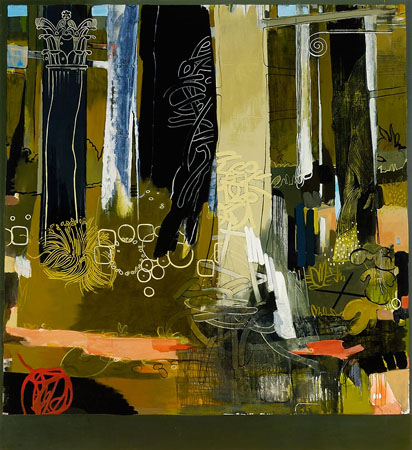
The visual impact of the oversized paintings lining the walls is stunning. Under high ceilings and northern light, each painting is a choreography of color and motion, memorable for the recurring dark green forest of trees glowing in beams of light. Many layers are required to achieve that high level of depth and spirit.
Frances began her journey in art at the tender age of three when, stricken with polio and strapped from ankles to chest in a restraint, only her arms had free movement, and she started drawing. She doesn’t recall how long that lasted, but it began a life-long love of making images.
Born in Boston, Massachusetts, and after undergrad work at University of Massachusetts, Frances came to California with, as she put it, “ a lot of unfounded confidence.” She attended San Francisco State, then went to UC Berkeley, where she obtained her MFA, all while working full time.
“I had some really unconventional jobs along the way, one as a laborer on a construction crew in San Francisco, then another in Seattle on a salmon processing ship,” she laughed, adding, “For many years I’ve only made really large paintings, and it has something to do with the physicality of the movement that I love, an element shared with those prior jobs.”
After Berkeley, Frances was invited to San Francisco State to teach a class, then taught at California College of the Arts for a couple of years, followed by 28 years at San Francisco Art Institute, retiring six months ago as Professor Emerita.
“I did a lot of drawing from life, which I still love for the freedom that connects eye to hand without involving my head in between. At Berkeley, I worked figuratively but had a real impulse to work abstractly; I struggled with how to do that without simply throwing paint around. I spent the summer after graduation from Berkeley making the worst paintings of my life, desperately looking for the shift that I could sense but not figure out.”
Asked who inspired her the most, she said, “Robert Hartman, who died a couple of years ago. He came to my studio and studied my work carefully, then offered a few significant comments. I truly appreciated that he was with the work instead of just layering it with his own stuff like some teachers do.”
I said her highly developed paintings would be identifiable half a block away—they’re undeniably Frances McCormack. A point of interest is the inclusion of an organic form commanding attention in the foreground, or sometimes partly hidden behind a tree.
“In my effort to move toward more abstract work, I used a hose as a compositional device,” she said. “Looking back, it may have been the first appearance of what later became roots, vines, stems, and sprites. I occasionally name them “sprites,” spirits of the natural world, when they are botanical but not figurative, kind of in-between.
“In most of my paintings, my original impulse is the excitement or recognition I feel when I see actual life forms such as botanical forms. The unfolding and pushing outward from a constricted form to become whatever it is, whether it’s a vine, seed, or bulb; that includes going in the other direction, falling away from the whole arc. Mostly it’s about going up, but there are other meditations on the descent.”
Asked for some encouraging words for up-and-coming artists, she said, “Be happy. Work at night. Cry for everything you want.” To be sure, she’s done all of that, and more.
Marc Katano
Marc was born in Tokyo, Japan, in 1952. His father, a Japanese American from Hawaii, was in the United States Army, and his mother was a Japanese national.
“We lived in Japan during most of my childhood, where I went to American schools,” he says. “English was my first language. Although I could speak Japanese to my mother, I did not learn to read or write Japanese. Living in Japan at the time, most of the signage and writing on the American bases was in Japanese Hiragana, Katakana, and Kanji, which are actually words and sounds, but to me they were little symbols or pictures that had no meaning. I’m sure this is the origin of my paintings and why I create symbols or forms that have no meaning beyond themselves.”
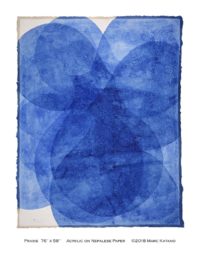 After graduating from high school in Tokyo, Marc went to the University of Hawaii for two years, then to California College of Arts and Crafts (now CCA) where he received a BFA with Distinction, in drawing.
After graduating from high school in Tokyo, Marc went to the University of Hawaii for two years, then to California College of Arts and Crafts (now CCA) where he received a BFA with Distinction, in drawing.
“I remember being told by one of my teachers, Ralph Borge, that the fastest way to learn to draw was with pen and ink, (no mistakes, you can’t erase),” Marc says. “Because I had completed all my academic requirements in Hawaii, I was able to take one life drawing class after another, for two years, using mainly a sharpened stick and ink, creating piles of failed drawings next to my bench.
“I use the same forms or symbols over and over again, until I understand them and exhaust their usage, then move on to another. This is the challenge and fun of painting. These symbols can be called my alphabet and each new series of paintings, a different language, i.e., Italian and French: same alphabet, different language. My painting, ‘Praxis’ in the show at SVMA, uses the same form or alphabet as my previous paintings, but this painting is part of a new series that uses that same form in transparent layers. It is painted on Nepalese paper with acrylic paint and a little India ink.”
Marc has been painting on paper exclusively for the last 10 years; usually Nepalese paper, which comes in 5’x10’ sheets, irregular in manufacture. “Each sheet is thinner, thicker, more or less rough, sometimes with little rusted pieces of metal, small stones and very little sizing. Sizing stops the paper from absorbing liquid. All these irregularities in manufacture make painting interesting and sometimes unpredictable.”
He maintains a practice of getting into the studio and painting every day. “I think there’s no such thing as ‘writer’s block.’ There are many periods when paintings don’t work, but you can never get to C without going through B. Art is about the challenge and the fun. If it’s not fun, what’s the point?”
His first solo exhibition in the United States was with the Stephen Wirtz Gallery in San Francisco in 1979. Marc added, “The gallery represented me until they closed in 2014. My first solo exhibition abroad was in 1983, with Studio Marconi, Milan, Italy. My current exhibition at Leslie Sacks Gallery in Santa Monica, which runs through May, will show the new series of blue paintings along with monotypes that were published and printed by Pelavin Editions, NYC in 2006.
“In the late ‘80s, photographer and wife, Nicole, and I moved to Los Angeles with our three-year-old son. He is a Public Defender there now, and we have lived in Sonoma for the last nine years. With its proximity to San Francisco, it has been an ideal place to continue our practices.”
Nicole Katano
Nicole Katano was born in Brooklyn and raised in Detroit. She spent a lot of time outside by herself and has clear, multi-sensory memories of seasonal changes in light and temperature. When she turned 17 she enrolled in film school at New York University’s Tisch School of the Arts, where she focused on cinematography.
“At NYU, I was the first female to even suggest such a notion at that school,” Nicole says. “The idea was met with derision by the professor in charge. It just wasn’t done at that time. There were many fewer opportunities for women in all areas, but I told the professor that I would be 100% responsible for the film we were shooting for our student films, and I was.”
After receiving her BFA in 1970, she accepted an opportunity to study sculpture at the Museum Art School in Portland, Oregon. Later, a job offer with Robert Brent, developing clay bodies and glazes for ceramists, brought her to the Bay Area. She pursued a Master’s degree in Ceramics from San Francisco State University, which she received in 1978.
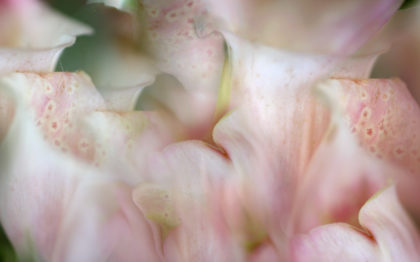
Nicole says, “After nine years of working with clay, I decided to return to my original interest in film. I also needed to deal more realistically with making a living, so I got a camera, made a portfolio, and started getting commercial photography work. I learned on the job, working my way up over the years from shooting handshakes and parties to photographing full scale advertising campaigns, directing a large crew of stylists and assistants. When my husband, artist Marc Katano, and I moved from San Francisco to Los Angeles in 1989, my career expanded to include shooting major national ad campaigns for companies such as Target, Disney, Warner Brothers, DreamWorks, Nokia, etc. I worked in Los Angeles for the next 22 years, supporting my family and raising our son. We moved to Sonoma in July 2010. The relative calm and closeness to nature are good for both Marc and me as we continue our work.”
In 2004, after spending so many years creating images for clients, Nicole returned to her personal work. The first pieces were diptychs and triptychs, which can be seen on her website.
“My aesthetic has been consistent throughout my career. I like to move around and shoot fast and I have always been partial to soft focus and blur. I’ve shot lots of black and white but I am fundamentally a colorist.
“I showed those first diptychs and triptychs at a solo exhibition in 2007 at George Billis Gallery, Los Angeles, and have since exhibited in galleries across the United States. My most recent solo exhibition, ‘Intangible,’ was in 2017 at Marin Art and Garden Center, where I showed layered images along with a large video projection, ‘As Way Opens.’”
Nicole’s newest images comment on the passage of time and the depth to be found in experience.
“I grow the plants, often from seed, then I photograph them. Using Photoshop, I combine single images into many-layered compositions. Part of this series is a layered, botanical image named ‘Inside Out,’ included in the SVMA exhibition.
“The nearly imperceptible variations of energy, evidence, and emotion intrigue me. My pictures are best understood on a sensual, nonlinear level. I use memory, scale, and the physical world to encourage a non-verbal experience in the viewer. My point is to feel, and thereby access the subtle, emotional, perceptive aspects of being.”
Sonoma Modern/Contemporary at The Sonoma Valley Museum of Art, 551 Broadway. Wednesday-Sunday, 11 a.m. to 5 p.m. $5-$10, Wed. free. Svma.org.



